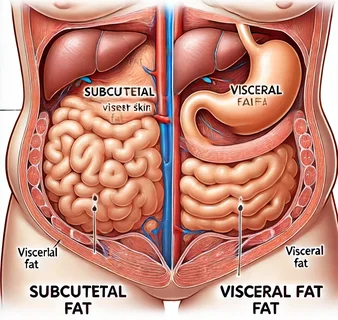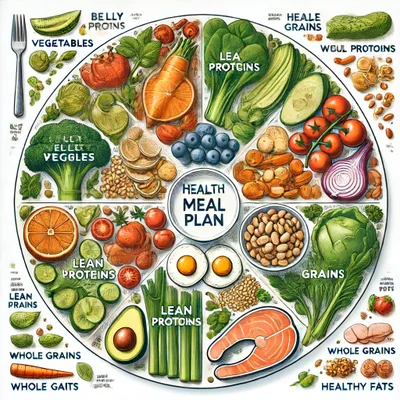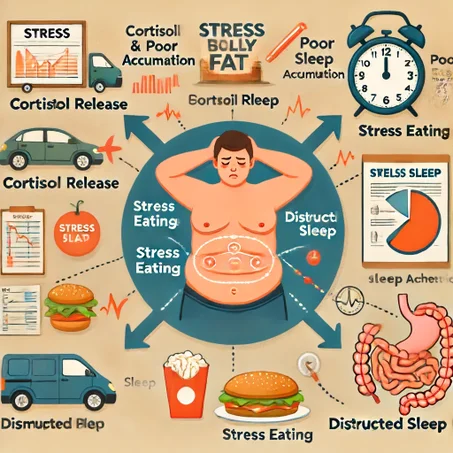Why Belly Fat Matters
Belly fat isn't just a nuisance that makes your clothes feel tight. It's seriously harmful. This type of fat — referred to as visceral fat — is a major risk factor for type 2 diabetes, heart disease, and other conditions.
Many health organizations use BMI (body mass index) to classify weight and predict the risk of metabolic disease. However, this is misleading, as people with excess belly fat are at an increased risk even if they look thin on the outside.
Understanding Subcutaneous vs. Visceral Fat
Belly fat can be divided into two categories: subcutaneous fat and visceral fat. Subcutaneous fat is the pinchable fat you can see and feel just under the skin.
Visceral fat, on the other hand, lies out of reach, deep within the abdominal cavity, where it pads the spaces between your abdominal organs.
Visceral fat is metabolically active and has been linked to various health issues, including insulin resistance, inflammation, and increased risk of chronic diseases.

Understanding Belly Fat
What Is Belly Fat?
Belly fat is the fat located around your abdomen. This includes both visceral and subcutaneous fat. Visceral fat is particularly harmful and is linked to various chronic diseases, while subcutaneous fat, although less dangerous, still contributes to an unhealthy body composition.
Why Belly Fat Is More Dangerous

Visceral fat is metabolically active, meaning it releases fatty acids, inflammatory agents, and hormones that contribute to diseases like heart disease and diabetes.
It also produces more proteins that cause inflammation in your body's tissues and organs.
This inflammation can lead to insulin resistance, which is a precursor to diabetes and other metabolic issues.
Health Risks of Belly Fat
Impact on Health
-
Heart Disease: Belly fat is a major risk factor for heart disease. The fatty acids produced by visceral fat are released into the bloodstream and can contribute to atherosclerosis (the hardening of the arteries), which increases the risk of heart attacks and strokes.
-
Type 2 Diabetes: Visceral fat affects the body's ability to use insulin effectively, leading to insulin resistance and increasing the risk of type 2 diabetes. Insulin resistance causes higher levels of insulin in the blood, which is associated with obesity, high blood pressure, and high levels of bad cholesterol.
-
High Blood Pressure: Excessive belly fat can contribute to hypertension by affecting kidney function and causing an imbalance in hormones that regulate blood pressure. Increased pressure on the kidneys can lead to retention of sodium, which in turn increases blood pressure.
-
Certain Cancers: Studies have shown a link between excess belly fat and an increased risk of certain cancers, including breast and colon cancer. This is believed to be due to the inflammation and hormonal changes caused by visceral fat.
Effective Strategies to Lose Belly Fat
Diet for Belly Fat
Nutritional Guidelines
-
Increase Soluble Fiber: Foods rich in soluble fiber help reduce visceral fat by promoting a feeling of fullness, which leads to less overall calorie intake. Good sources include oats, flaxseeds, avocados, legumes, and blackberries.
-
Embrace Protein-Rich Foods: High-protein diets help in weight management and belly fat reduction. They increase the levels of the satiety hormone, reduce hunger, and promote muscle preservation during weight loss. Consider lean meats, fish, eggs, dairy, beans, and legumes.
-
Focus on Fiber-Rich Foods: Fiber-rich foods help improve digestion and keep you feeling full longer. Include plenty of vegetables, fruits, whole grains, and legumes in your diet.
-
Incorporate Healthy Fats: Healthy fats, such as those found in avocados, nuts, seeds, and olive oil, can help reduce inflammation and promote belly fat loss.
-
Stay Hydrated: Drinking water can help control appetite and support overall health. Aim for at least 8 glasses of water a day.
Foods to Avoid
-
Limit Added Sugars: Added sugars are linked to several chronic diseases, including belly fat accumulation. Avoid sugary beverages, candies, baked goods, and processed foods.
-
Avoid Trans Fats: Trans fats are created by adding hydrogen to unsaturated fats, which are found in some margarines and spreads and often added to packaged foods. These fats have been linked to inflammation, heart disease, and belly fat gain.
-
Reduce Refined Carbs: Refined carbohydrates, such as white bread and pasta, can cause spikes in blood sugar levels and lead to increased fat storage, particularly in the belly area.
-
Limit Alcohol: Excessive alcohol consumption is linked to increased belly fat. Alcoholic beverages are high in calories and can also lead to poor food choices.
List of Foods to Avoid
- Sugary beverages
- Candies and baked goods
- Processed foods with added sugars
- Margarines and spreads with trans fats
- White bread and pasta
- Excessive alcohol
Dietary Plans

-
Mediterranean Diet: This diet emphasizes whole grains, healthy fats, fruits, vegetables, nuts, and lean protein sources. It is associated with numerous health benefits, including reduced belly fat.
-
Balanced Meal Planning: Plan meals that include a balance of macronutrients (proteins, fats, and carbohydrates) to ensure you're getting a variety of nutrients and maintaining a caloric deficit for weight loss.
-
Low-Carb Diet: Reducing carbohydrate intake can be very effective for losing fat, including belly fat. Low-carb diets can lead to significant reductions in belly fat.
Hydration
-
Importance of Drinking Water: Staying hydrated helps your body function optimally, aids in digestion, and can help control calorie intake.
-
Avoid Sugary Beverages: Sugary drinks are high in calories and can contribute significantly to weight gain and belly fat. Opt for water, herbal teas, or black coffee instead.
Exercise for Belly Fat
Cardio Workouts
-
Benefits of Aerobic Exercise: Cardio workouts are effective in burning calories and improving cardiovascular health. They help reduce overall body fat, including belly fat.
-
Examples: Running, swimming, biking, and brisk walking are great cardio exercises to incorporate into your fitness routine.
-
Exercise Intensity: High-intensity cardio exercises can burn more calories in less time. Aim for a mix of moderate and high-intensity workouts for the best results.
Strength Training
-
Importance of Building Muscle: Muscle tissue burns more calories than fat tissue, even at rest. Strength training helps build muscle mass, which can boost your metabolism and aid in belly fat loss.
-
Core Exercises: Focus on exercises that target the abdominal muscles, such as crunches, planks, and side planks, to strengthen your core.
-
Full-Body Workouts: Incorporating exercises that work for multiple muscle groups, such as squats, deadlifts, and bench presses, can be more effective for overall fat loss.
High-Intensity Interval Training (HIIT)
-
How HIIT Helps Burn Fat: HIIT involves short bursts of intense exercise followed by rest or low-intensity exercise. It can help burn more calories in less time and is effective for fat loss, including belly fat.
-
Sample HIIT Routines: Try routines that alternate between exercises like sprinting, burpees, jumping jacks, and high knees with short rest periods.
Effective Exercises
| Exercise Type | Example |
|---|---|
| Cardio Workouts | Running, Swimming, Biking |
| Strength Training | Squats, Deadlifts, Bench Presses |
| Core Exercises | Crunches, Planks, Side Planks |
| High-Intensity Interval | Sprinting, Burpees, Jumping Jacks |
Lifestyle Changes
Sleep
-
Importance of Quality Sleep: Poor sleep is linked to weight gain and an increase in belly fat. Aim for 7-8 hours of quality sleep per night.
-
Tips for Better Sleep: Maintain a regular sleep schedule, create a restful environment, avoid caffeine and electronics before bed, and engage in relaxing activities like reading or meditation.

Stress Management
-
Impact of Stress on Belly Fat: Chronic stress can lead to weight gain and increased belly fat through the production of cortisol, a stress hormone that promotes fat storage in the abdominal area.
-
Techniques to Reduce Stress: Practice stress-reducing techniques such as yoga, meditation, deep breathing exercises, and regular physical activity
Daily Habits
-
Move More, Sit Less: Incorporate more movement into your daily routine. Take the stairs, walk or bike to work, and take breaks to stretch and move throughout the day.
-
Benefits of Fidgeting and Staying Active: Even small movements like fidgeting can increase your daily calorie expenditure and help with weight management.
-
Mindful Eating: Pay attention to your hunger and fullness cues, and avoid eating out of boredom or stress.
Lifestyle Tips
- Maintain a regular sleep schedule
- Practice stress-reducing techniques
- Incorporate movement into daily routines
- Pay attention to hunger and fullness cues
Advanced Strategies
Intermittent Fasting
-
How Intermittent Fasting Works: Intermittent fasting involves cycling between periods of eating and fasting. It can help reduce calorie intake and improve metabolic health.
-
Different Methods of Intermittent Fasting: Common methods include the 16/8 method (16 hours of fasting, 8 hours of eating), the 5:2 method (eating normally for 5 days, and restricting calories for 2 days), and the eat-stop-eat method (24-hour fasts once or twice a week).
Probiotics and Gut Health
-
Role of Gut Bacteria in Weight Loss: A healthy gut microbiome can influence weight management and fat storage. Probiotics can help maintain a healthy balance of gut bacteria.
-
Foods and Supplements for Gut Health: Include probiotic-rich foods like yogurt, kefir, sauerkraut, and kimchi in your diet. Consider taking a probiotic supplement if needed.
-
Prebiotics: Foods that feed the good bacteria in your gut, such as garlic, onions, asparagus, and bananas, can also support gut health and weight management.
Common Myths About Belly Fat
Spot Reduction Myth
1. Why You Can't Target Belly Fat with Exercises: Spot reduction, or the idea that you can lose fat from a specific part of your body by exercising that area, is a myth. Fat loss occurs throughout the body based on genetics and overall fat loss.
Miracle Diets and Supplements
2. The Truth About Weight Loss Pills and Quick Fixes: There are no magic pills or quick fixes for belly fat loss. Sustainable weight loss requires a combination of healthy eating, regular exercise, and lifestyle changes.
Monitoring Progress

Tracking Your Journey
-
Importance of Keeping a Food Diary: Recording what you eat can help you stay accountable and make better food choices. Use apps or journals to track your intake and progress.
-
Using Apps and Tools for Tracking: Fitness apps can help you monitor your calorie intake, exercise routines, and progress. Popular options include MyFitnessPal, Lose It!, and Fitbit.
Measuring Success
-
How to Measure Belly Fat: Use a measuring tape to track your waist circumference and monitor changes over time. Aim for a waist circumference below 35 inches for women and 40 inches for men.
-
Setting Realistic Goals: Set achievable and sustainable goals for belly fat loss. Celebrate small milestones to stay motivated and maintain your progress.
Conclusion
Consistency Is Key
Building sustainable habits is crucial for long-term belly fat loss. Stay committed to your diet, exercise routine, and lifestyle changes.
Stay Motivated
Celebrate small wins and seek support from friends, family, or online communities. Consider working with a fitness professional or nutritionist to stay on track.
By following these comprehensive strategies and maintaining a balanced approach, you can effectively lose belly fat and improve your overall health. Remember, consistency and commitment are key to achieving lasting results.
Frequently asked questions
NEW "purple tea" melts 2lbs daily
I'm sure you've been told that drinking tea in the morning can help you lose weight, however…
That's completely not true.
I know people who drink tons of green and black tea yet their weight NEVER budges.
The good news is…
There's a new type of "purple tea" you can have right at home…
That melts away stubborn belly fat like crazy.
My friend Liz used it to drop over 100 pounds when Weight Watchers and keto failed her.






Add comment
Comments